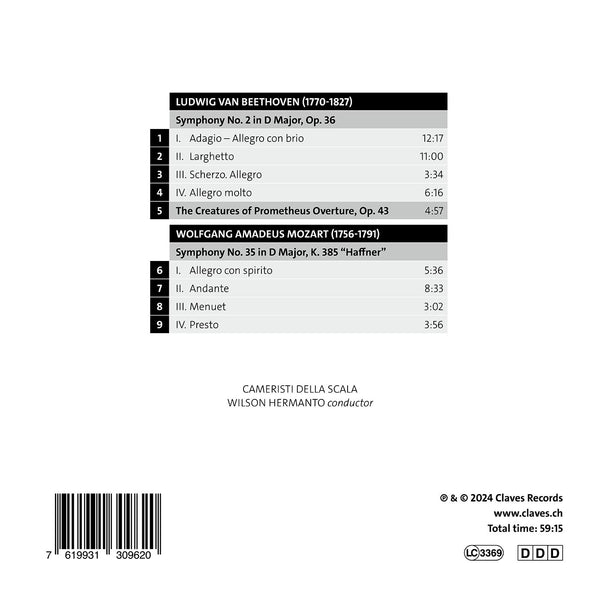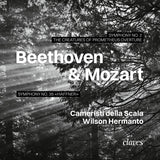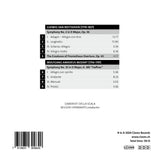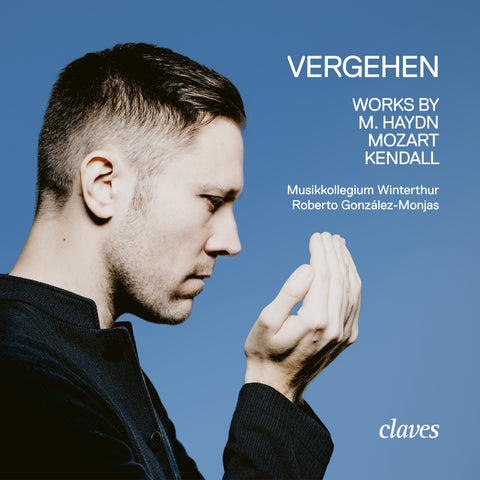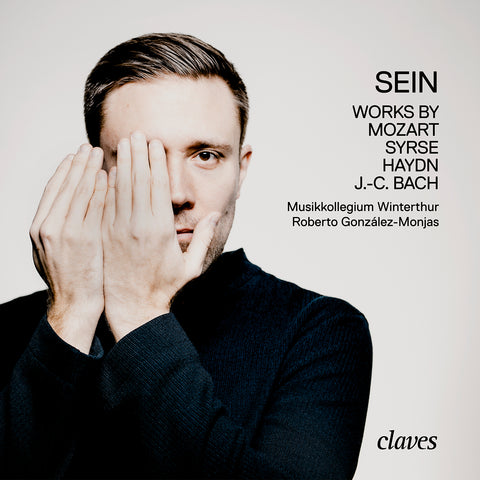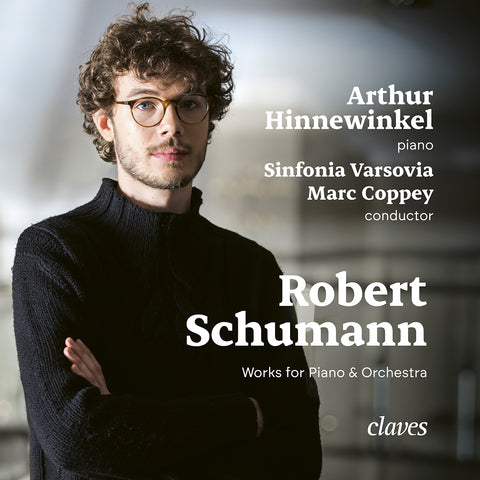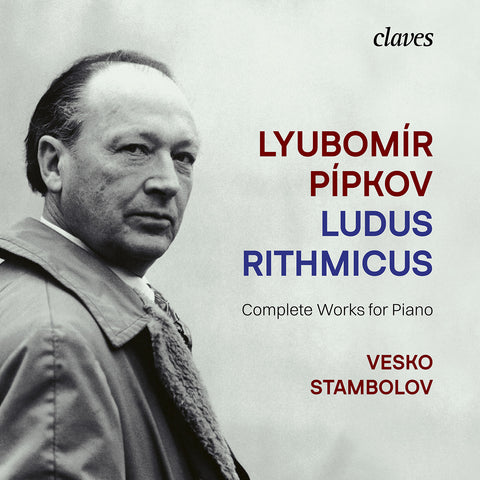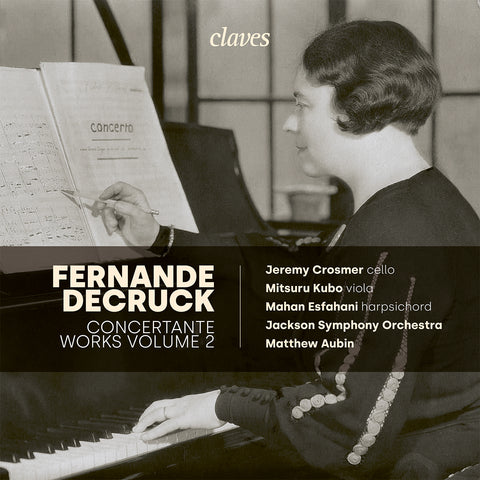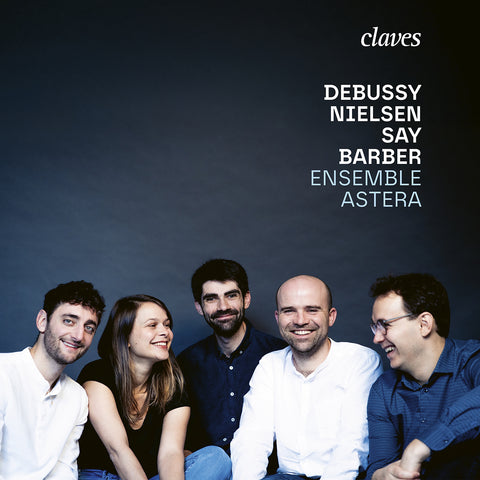(2024) Beethoven & Mozart - Cameristi della Scala, Wilson Hermanto
Category(ies): Orchestra Repertoire
Main Composer: Ludwig van Beethoven
Orchestra: Cameristi della Scala
Conductor: Wilson Hermanto
CD set: 1
Catalog N°:
CD 3096
Release: 08.11.2024
EAN/UPC: 7619931309620
This album is now on repressing. Pre-order it at a special price now.
CHF 18.50
This album is no longer available on CD.
This album has not been released yet. Pre-order it from now.
CHF 18.50
This album is no longer available on CD.
CHF 18.50
VAT included for Switzerland & UE
Free shipping
This album is no longer available on CD.
VAT included for Switzerland & UE
Free shipping
This album is now on repressing. Pre-order it at a special price now.
CHF 18.50
This album is no longer available on CD.
This album has not been released yet.
Pre-order it at a special price now.
CHF 18.50
This album is no longer available on CD.
CHF 18.50
This album is no longer available on CD.
BEETHOVEN & MOZART - CAMERISTI DELLA SCALA, WILSON HERMANTO
About this album
Symphony No. 2 in D major, Op. 36 (1802)
Ludwig van Beethoven (Bonn, 1770 – Vienna, 1827)
It is fascinating to trace the gradual process by which the young Beethoven found his personal voice as a composer. The so-called “heroic” style, in which many see the “quintessential” Beethoven, may have been born with the Third Symphony, the Eroica. But this style was not born overnight. Already in the First Symphony (1799-1800), there are signs of a new musical world taking shape. In the Second, any echoes of Haydn and Mozart are secondary in a style that is moving in an entirely new direction.
Soon after the first fortissimo D that begins the symphony’s opening “Adagio molto,” it becomes clear that we are listening to no ordinary symphonic introduction. The first great change is in the orchestration: the opening melody is given to the woodwinds while the strings are silent. It is the first indication that the winds will have much more to do in this symphony than merely doubling the strings and taking a solo or two, as was the custom in earlier works. When the woodwind melody is repeated and expanded by the strings, we know that the equal balance between these orchestral sections was a primary concern of the composer’s.
There are other novelties. The music embarks on a series of modulations to distant tonalities; the strings scurry up and down in passages of rapid thirty-second notes into which the horns inject some strong off-beat accents. One can recognize Mozart’s “Prague” Symphony (in the same key of D major) as a model, but Beethoven packed a far greater number of events into little more than two minutes of music. [read more in the booklet]
Overture to The Creatures of Prometheus, Op. 43 (1801)
Ludwig van Beethoven
By the time he was thirty, Beethoven had long achieved the status of a celebrity in Vienna, the imperial capital where he had made his home since he was 22. With his works written shortly before the beginning of the 19th century such as the “Pathétique” sonata, the first six string quartets and the First Symphony, he had established his unique position in Viennese musical life, and his fame had begun to spread beyond the limits of the city.
It was logical that such a prominent young composer should receive a commission from the Imperial Theatre. In 1800, Beethoven was asked to write a ballet score for a court entertainment conceived by Salvatore Viganò (1769-1821), an Italian-born dancer and choreographer with a European reputation. Viganò followed the lead of Jean-George Noverre, who had simplified the more complicated, stylized artistry of earlier ballet masters by introducing some simple yet expressive pantomimic elements. Viganò’s approach was at first controversial in Vienna where the earlier style had long held sway, yet his natural, unaffected style gradually conquered the city’s ballet-lovers. [read more in the booklet]
Symphony No. 35 (“Haffner”) in D major, K. 385 (1782)
Wolfgang Amadeus Mozart (Salzburg, 1756 - Vienna, 1791)
The members of the Haffner family were good friends of the Mozarts in Salzburg. Sigmund Haffner the Elder (1699-1772) had been a wealthy merchant and the mayor of the city. In his house, a great deal of music could be heard, with both father Leopold and son Wolfgang Mozart frequently participating. The relations continued after the mayor’s death, and when his daughter Maria Elisabeth Haffner (1753-1784) was going to be married in 1776, Mozart was asked to write some festive music for the wedding. The resulting “Haffner” Serenade (K. 250) was so successful that six years later, when another cause for celebration arose, the composer received a new commission from the family. This time the occasion was Sigmund Haffner the Younger’s (1756-1787) elevation to nobility.
In the meantime, Mozart had left his hometown and moved to Vienna, where his fame was rapidly advancing. When the request from Salzburg reached him in July 1782, his opera The Abduction from the Seraglio had just been premiered, and he was busy arranging selections from it for wind ensemble. In addition, his wedding with Constanze Weber was imminent and he was preparing to move to new quarters. Under these circumstances, the composition of the new symphony went more slowly than father Leopold, anxious for the symphony to arrive in time for the festivities, might have wished. Nevertheless, Mozart managed to send the score in time. On August 24, he was able to write to his father: “I am delighted that the symphony is to your taste.” [read more in the booklet]
Cameristi della Scala
The chamber orchestra “Cameristi della Scala”, composed of musicians from the Orchestra del Teatro alla Scala di Milano, was founded in 1982. The hallmark of this chamber orchestra is to perform with or without a conductor. Its core repertoire includes many masterpieces ranging from the 18th century to the present day, as well as passionately promoting and championing the works of lesser-known composers. The Cameristi della Scala regularly performs with world renowned musicians such as Maxim Vengerov, Gautier Capuçon, Renaud Capuçon, Francesco Piemontesi, Alexandre Kantorow, Khatia Buniatishvili, Jan Lisiecki, David Fray, Till Fellner, Daniel Müller-Schott, Sergei Babayan, Alexei Volodin, Daniel Lozakovich, Giovanni Sollima, Nils Mönkemeyer as well as features the Principals of the La Scala Orchestra in the capacity of soloists. Many celebrated conductors who conducted at the Teatro alla Scala in the past to present day, have significantly influenced the character and sound of the Cameristi della Scala, well-known for their distinctive Italian sound and musical phrasing.
The Cameristi della Scala has performed in many prestigious venues, concert halls and music festivals around the world including the Carnegie Hall in New York, the Library of Congress in Washington D.C., Salle Gaveau in Paris, Tchaikovsky Hall in Moscow, Tonhalle in Zürich, Mann Auditorium in Tel Aviv, Victoria Hall in Geneva, Teatro Coliseo in Buenos Aires, Narodowa Opera Theatre in Warsaw, George Enescu Festival in Bucharest, Vevey Spring Classic Festival in Switzerland, Tbilisi Autumn Festival in Georgia, Izmir International Festival in Turkey and many others. In one of their annual concerts at the Teatro alla Scala, the orchestra performed a program in honor of Leonard Bernstein’s Centennial Anniversary in 2018. In collaboration with the superstar dancer Roberto Bolle, the Cameristi della Scala shared the stage with him for a performance at the 2018 World Economic Forum in Davos, Switzerland.
The Cameristi della Scala received the Premio Isimbardi (Isimbardi Award) from the Province of Milan in 2012 as a recognition of their outstanding contribution to the community and the prestige of the city of Milan in the world. Following his outstanding debut with the orchestra, the conductor Wilson Hermanto was appointed Principal Guest Conductor in 2017. In their close and ongoing relationship, the orchestra and Maestro Hermanto have, to date, given numerous concerts in Italy, France, Germany, Switzerland, Austria, Romania, Turkey and look forward to many more future projects, local and international, in collaboration with internationally renowned soloists.
[website]
Wilson Hermanto, conductor
Praised for his deep musicianship, natural authority, exuberant energy and elegance, Wilson Hermanto is the Principal Guest Conductor of the chamber orchestra Cameristi della Scala since 2017. In 2023-24 season Mr. Hermanto makes a welcome return to the prestigious Enescu Festival with the Cameristi della Scala and also takes the orchestra to France and Switzerland with soloists Francesco Piemontesi, Daniel Müller-Schott, Pierre Génisson, Daniel Ciobanu. The current season also sees Mr. Hermanto making return engagements with the Warsaw Philharmonic Orchestra to close the 2023 Warsaw Autumn Festival and the NFM Leopoldinum Orchestra in Wrocław. Together with Daniel Müller-Schott, Wilson Hermanto is the Co-Artistic Director of the Vevey Spring Classic music festival in Switzerland since 2022.
As a guest conductor, in the recent past Mr. Hermanto conducted Leonard Bernstein “Candide” with the Baltic Opera in Poland and worked with the Sinfonia Varsovia, Polish National Radio Symphony Orchestra, Orchestre national de Metz, George Enescu Philharmonic, Philharmonisches Orchester Heidelberg, Argovia Philharmonic, Orquesta Sinfónica Nacional de Chile, Mariinsky Orchestra, Szczecin Philharmonic Orchestra, North Czech Philharmonic Orchestra, Orquesta Filarmónica de Bogotá, Orchestra of Accademia del Teatro alla Scala and Schweizer Jugend Sinfonie Orchester. With the Cameristi della Scala, in addition to performances in Italy that include the Teatro alla Scala di Milano, Mr. Hermanto and the orchestra has performed in Germany, Austria, France, Switzerland, Romania and Turkey.
Wilson Hermanto performs regularly in France where he conducted various important French orchestras such as Orchestre national de Lyon, Orchestre philharmonique de radio France, Orchestre national du Capitole de Toulouse, Orchestre de chambre de Paris, Orchestre national d’Île de France, Orchestre national de Bretagne, etc. Around the globe Mr. Hermanto has worked with the Cleveland Orchestra, Deutsche Radio Philharmonie Saarbrücken, Prague Symphony Orchestra, London Philharmonic Orchestra, BBC National Orchestra of Wales, Orchestra della Svizzera Italiana, Orchestre de chambre de Lausanne, NDR Radio Philharmonie Hannover, Ulster Orchestra, Florida Orchestra, English Chamber Orchestra, Malaysian Philharmonic Orchestra, Orchestre de chambre de Genève, Ensemble Contrechamps, etc.
With a large repertoire encompassing the Baroque period until the music of our time, Wilson Hermanto conducted and worked with many renowned contemporary composers such as Zygmunt Krauze, Bruno Mantovani, Jörg Widmann, Agata Zubel, Thuridur Jónsdóttir, Helmut Lachenmann, Giovanni Sollima,
Magdalena Długosz, H.K Gruber, Matteo Franceschini, Enno Poppe, Teoniki Rożynek, Wojciech Błazejczyk and Lowell Liebermann. Various soloists with whom Mr. Hermanto has worked together include Maxim Vengerov, Lang Lang, Gautier Capuçon, Daniel Müller-Schott, David Fray, Till Fellner, Alexei Volodin, Alina Pogostkina, Carolin Widmann, Nils Mönkemeyer, Kian Soltani, Richard Galliano, Radek Baborák and the Trio Wanderer.
Born in Indonesia of Chinese descent and a long time Swiss resident, Wilson Hermanto graduated from the Peabody Conservatory of Music majoring in violin and obtained the conducting degree from the Manhattan School of Music studying with the late Swedish Maestro, Sixten Ehrling. Sir Colin Davis became a close mentor who took personal interest in shaping Mr. Hermanto’s conducting skills. Mr. Hermanto also studied conducting with Carlo Maria Giulini at Scuola Musica di Fiesole and was a Conducting Fellow at the Tanglewood Music Centre working with Seiji Ozawa and also a Conducting Fellow at the Lucerne Festival Academy under the tutelage of Pierre Boulez.
[website]
REVIEWS
"Wilson Hermanto concentrates on rhythmic emphasis, especially in the fast movements, and the orchestra plays with bite and commitment. The Larghetto brings some calm and serenity to this exciting bustle. Mozart’s Haffner Symphony is a bit more elegant, but no less lively and vibrant. Here, too, there is a refreshing verve that, like Beethoven’s, keeps the music in a constant state of suspense." - Guy Engels, December 2024
"La fougueuse Ouverture des Créatures de Prométhée, op. 43 parachève le pan beethovénien du disque qui comporte encore la Symphonie n°35, dite « Haffner », de Mozart dont la gaieté et la virtuosité sont des plus communicatives sous la direction de Wilson Hermanto. A l’heure où les lectures dites historiquement informées ont souvent préséance, l’ensemble italien et leur chef prouvent qu’il reste possible de proposer une approche vive et habitée de ce répertoire. Une lecture que l’on catégorisera de musicalement très bien informée !" - Scènes Magazine, November 2024
"[..] The La Scala players bring joyful exuberance to the 32 year old Beethoven’s Second Symphony with its brilliant interplay of themes between brass, woodwind and strings in the opening Allegro con brio. The exquisite lyrical Larghetto follows, before the scintillating Scherzo and Allegro Molto, its witty turns of phrase heralding the 7th and 9th symphonies. We hear the jovial composer entirely at odds with the taciturn one of his later years. [..]" - Mary Nemet, March 2025
(2024) Beethoven & Mozart - Cameristi della Scala, Wilson Hermanto - CD 3096
About this album
Symphony No. 2 in D major, Op. 36 (1802)
Ludwig van Beethoven (Bonn, 1770 – Vienna, 1827)
It is fascinating to trace the gradual process by which the young Beethoven found his personal voice as a composer. The so-called “heroic” style, in which many see the “quintessential” Beethoven, may have been born with the Third Symphony, the Eroica. But this style was not born overnight. Already in the First Symphony (1799-1800), there are signs of a new musical world taking shape. In the Second, any echoes of Haydn and Mozart are secondary in a style that is moving in an entirely new direction.
Soon after the first fortissimo D that begins the symphony’s opening “Adagio molto,” it becomes clear that we are listening to no ordinary symphonic introduction. The first great change is in the orchestration: the opening melody is given to the woodwinds while the strings are silent. It is the first indication that the winds will have much more to do in this symphony than merely doubling the strings and taking a solo or two, as was the custom in earlier works. When the woodwind melody is repeated and expanded by the strings, we know that the equal balance between these orchestral sections was a primary concern of the composer’s.
There are other novelties. The music embarks on a series of modulations to distant tonalities; the strings scurry up and down in passages of rapid thirty-second notes into which the horns inject some strong off-beat accents. One can recognize Mozart’s “Prague” Symphony (in the same key of D major) as a model, but Beethoven packed a far greater number of events into little more than two minutes of music. [read more in the booklet]
Overture to The Creatures of Prometheus, Op. 43 (1801)
Ludwig van Beethoven
By the time he was thirty, Beethoven had long achieved the status of a celebrity in Vienna, the imperial capital where he had made his home since he was 22. With his works written shortly before the beginning of the 19th century such as the “Pathétique” sonata, the first six string quartets and the First Symphony, he had established his unique position in Viennese musical life, and his fame had begun to spread beyond the limits of the city.
It was logical that such a prominent young composer should receive a commission from the Imperial Theatre. In 1800, Beethoven was asked to write a ballet score for a court entertainment conceived by Salvatore Viganò (1769-1821), an Italian-born dancer and choreographer with a European reputation. Viganò followed the lead of Jean-George Noverre, who had simplified the more complicated, stylized artistry of earlier ballet masters by introducing some simple yet expressive pantomimic elements. Viganò’s approach was at first controversial in Vienna where the earlier style had long held sway, yet his natural, unaffected style gradually conquered the city’s ballet-lovers. [read more in the booklet]
Symphony No. 35 (“Haffner”) in D major, K. 385 (1782)
Wolfgang Amadeus Mozart (Salzburg, 1756 - Vienna, 1791)
The members of the Haffner family were good friends of the Mozarts in Salzburg. Sigmund Haffner the Elder (1699-1772) had been a wealthy merchant and the mayor of the city. In his house, a great deal of music could be heard, with both father Leopold and son Wolfgang Mozart frequently participating. The relations continued after the mayor’s death, and when his daughter Maria Elisabeth Haffner (1753-1784) was going to be married in 1776, Mozart was asked to write some festive music for the wedding. The resulting “Haffner” Serenade (K. 250) was so successful that six years later, when another cause for celebration arose, the composer received a new commission from the family. This time the occasion was Sigmund Haffner the Younger’s (1756-1787) elevation to nobility.
In the meantime, Mozart had left his hometown and moved to Vienna, where his fame was rapidly advancing. When the request from Salzburg reached him in July 1782, his opera The Abduction from the Seraglio had just been premiered, and he was busy arranging selections from it for wind ensemble. In addition, his wedding with Constanze Weber was imminent and he was preparing to move to new quarters. Under these circumstances, the composition of the new symphony went more slowly than father Leopold, anxious for the symphony to arrive in time for the festivities, might have wished. Nevertheless, Mozart managed to send the score in time. On August 24, he was able to write to his father: “I am delighted that the symphony is to your taste.” [read more in the booklet]
Cameristi della Scala
The chamber orchestra “Cameristi della Scala”, composed of musicians from the Orchestra del Teatro alla Scala di Milano, was founded in 1982. The hallmark of this chamber orchestra is to perform with or without a conductor. Its core repertoire includes many masterpieces ranging from the 18th century to the present day, as well as passionately promoting and championing the works of lesser-known composers. The Cameristi della Scala regularly performs with world renowned musicians such as Maxim Vengerov, Gautier Capuçon, Renaud Capuçon, Francesco Piemontesi, Alexandre Kantorow, Khatia Buniatishvili, Jan Lisiecki, David Fray, Till Fellner, Daniel Müller-Schott, Sergei Babayan, Alexei Volodin, Daniel Lozakovich, Giovanni Sollima, Nils Mönkemeyer as well as features the Principals of the La Scala Orchestra in the capacity of soloists. Many celebrated conductors who conducted at the Teatro alla Scala in the past to present day, have significantly influenced the character and sound of the Cameristi della Scala, well-known for their distinctive Italian sound and musical phrasing.
The Cameristi della Scala has performed in many prestigious venues, concert halls and music festivals around the world including the Carnegie Hall in New York, the Library of Congress in Washington D.C., Salle Gaveau in Paris, Tchaikovsky Hall in Moscow, Tonhalle in Zürich, Mann Auditorium in Tel Aviv, Victoria Hall in Geneva, Teatro Coliseo in Buenos Aires, Narodowa Opera Theatre in Warsaw, George Enescu Festival in Bucharest, Vevey Spring Classic Festival in Switzerland, Tbilisi Autumn Festival in Georgia, Izmir International Festival in Turkey and many others. In one of their annual concerts at the Teatro alla Scala, the orchestra performed a program in honor of Leonard Bernstein’s Centennial Anniversary in 2018. In collaboration with the superstar dancer Roberto Bolle, the Cameristi della Scala shared the stage with him for a performance at the 2018 World Economic Forum in Davos, Switzerland.
The Cameristi della Scala received the Premio Isimbardi (Isimbardi Award) from the Province of Milan in 2012 as a recognition of their outstanding contribution to the community and the prestige of the city of Milan in the world. Following his outstanding debut with the orchestra, the conductor Wilson Hermanto was appointed Principal Guest Conductor in 2017. In their close and ongoing relationship, the orchestra and Maestro Hermanto have, to date, given numerous concerts in Italy, France, Germany, Switzerland, Austria, Romania, Turkey and look forward to many more future projects, local and international, in collaboration with internationally renowned soloists.
[website]
Wilson Hermanto, conductor
Praised for his deep musicianship, natural authority, exuberant energy and elegance, Wilson Hermanto is the Principal Guest Conductor of the chamber orchestra Cameristi della Scala since 2017. In 2023-24 season Mr. Hermanto makes a welcome return to the prestigious Enescu Festival with the Cameristi della Scala and also takes the orchestra to France and Switzerland with soloists Francesco Piemontesi, Daniel Müller-Schott, Pierre Génisson, Daniel Ciobanu. The current season also sees Mr. Hermanto making return engagements with the Warsaw Philharmonic Orchestra to close the 2023 Warsaw Autumn Festival and the NFM Leopoldinum Orchestra in Wrocław. Together with Daniel Müller-Schott, Wilson Hermanto is the Co-Artistic Director of the Vevey Spring Classic music festival in Switzerland since 2022.
As a guest conductor, in the recent past Mr. Hermanto conducted Leonard Bernstein “Candide” with the Baltic Opera in Poland and worked with the Sinfonia Varsovia, Polish National Radio Symphony Orchestra, Orchestre national de Metz, George Enescu Philharmonic, Philharmonisches Orchester Heidelberg, Argovia Philharmonic, Orquesta Sinfónica Nacional de Chile, Mariinsky Orchestra, Szczecin Philharmonic Orchestra, North Czech Philharmonic Orchestra, Orquesta Filarmónica de Bogotá, Orchestra of Accademia del Teatro alla Scala and Schweizer Jugend Sinfonie Orchester. With the Cameristi della Scala, in addition to performances in Italy that include the Teatro alla Scala di Milano, Mr. Hermanto and the orchestra has performed in Germany, Austria, France, Switzerland, Romania and Turkey.
Wilson Hermanto performs regularly in France where he conducted various important French orchestras such as Orchestre national de Lyon, Orchestre philharmonique de radio France, Orchestre national du Capitole de Toulouse, Orchestre de chambre de Paris, Orchestre national d’Île de France, Orchestre national de Bretagne, etc. Around the globe Mr. Hermanto has worked with the Cleveland Orchestra, Deutsche Radio Philharmonie Saarbrücken, Prague Symphony Orchestra, London Philharmonic Orchestra, BBC National Orchestra of Wales, Orchestra della Svizzera Italiana, Orchestre de chambre de Lausanne, NDR Radio Philharmonie Hannover, Ulster Orchestra, Florida Orchestra, English Chamber Orchestra, Malaysian Philharmonic Orchestra, Orchestre de chambre de Genève, Ensemble Contrechamps, etc.
With a large repertoire encompassing the Baroque period until the music of our time, Wilson Hermanto conducted and worked with many renowned contemporary composers such as Zygmunt Krauze, Bruno Mantovani, Jörg Widmann, Agata Zubel, Thuridur Jónsdóttir, Helmut Lachenmann, Giovanni Sollima,
Magdalena Długosz, H.K Gruber, Matteo Franceschini, Enno Poppe, Teoniki Rożynek, Wojciech Błazejczyk and Lowell Liebermann. Various soloists with whom Mr. Hermanto has worked together include Maxim Vengerov, Lang Lang, Gautier Capuçon, Daniel Müller-Schott, David Fray, Till Fellner, Alexei Volodin, Alina Pogostkina, Carolin Widmann, Nils Mönkemeyer, Kian Soltani, Richard Galliano, Radek Baborák and the Trio Wanderer.
Born in Indonesia of Chinese descent and a long time Swiss resident, Wilson Hermanto graduated from the Peabody Conservatory of Music majoring in violin and obtained the conducting degree from the Manhattan School of Music studying with the late Swedish Maestro, Sixten Ehrling. Sir Colin Davis became a close mentor who took personal interest in shaping Mr. Hermanto’s conducting skills. Mr. Hermanto also studied conducting with Carlo Maria Giulini at Scuola Musica di Fiesole and was a Conducting Fellow at the Tanglewood Music Centre working with Seiji Ozawa and also a Conducting Fellow at the Lucerne Festival Academy under the tutelage of Pierre Boulez.
[website]
REVIEWS
"Wilson Hermanto concentrates on rhythmic emphasis, especially in the fast movements, and the orchestra plays with bite and commitment. The Larghetto brings some calm and serenity to this exciting bustle. Mozart’s Haffner Symphony is a bit more elegant, but no less lively and vibrant. Here, too, there is a refreshing verve that, like Beethoven’s, keeps the music in a constant state of suspense." - Guy Engels, December 2024
"La fougueuse Ouverture des Créatures de Prométhée, op. 43 parachève le pan beethovénien du disque qui comporte encore la Symphonie n°35, dite « Haffner », de Mozart dont la gaieté et la virtuosité sont des plus communicatives sous la direction de Wilson Hermanto. A l’heure où les lectures dites historiquement informées ont souvent préséance, l’ensemble italien et leur chef prouvent qu’il reste possible de proposer une approche vive et habitée de ce répertoire. Une lecture que l’on catégorisera de musicalement très bien informée !" - Scènes Magazine, November 2024
"[..] The La Scala players bring joyful exuberance to the 32 year old Beethoven’s Second Symphony with its brilliant interplay of themes between brass, woodwind and strings in the opening Allegro con brio. The exquisite lyrical Larghetto follows, before the scintillating Scherzo and Allegro Molto, its witty turns of phrase heralding the 7th and 9th symphonies. We hear the jovial composer entirely at odds with the taciturn one of his later years. [..]" - Mary Nemet, March 2025
Return to the album | Read the booklet | Open online links | Composer(s): Ludwig van Beethoven | Main Artist: Cameristi della Scala







